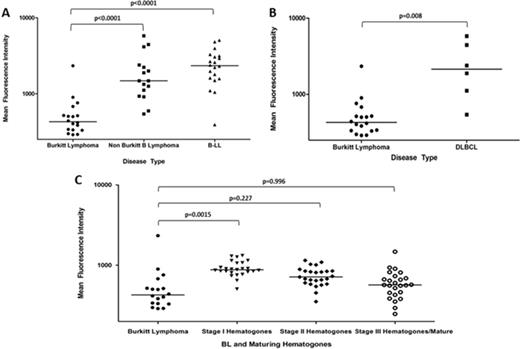Abstract
Introduction: Burkitt Lymphoma (BL) is a highly aggressive mature B cell neoplasm comprising 30% of Non-Hodgkin lymphoma in children. BL can be difficult to discriminate from other mature B cell lymphomas, and distinguishing BL from Diffuse Large B Cell Lymphoma (DLBCL) is a commonly encountered diagnostic dilemma. While c-myc translocation as detected by fluorescence in situ hybridization is more often associated with BL, DLBCLs may also have the translocation, and therapy is often started prior to obtaining this result. Early and rapidly obtained diagnostic clues would therefore be helpful to establish the appropriate therapeutic regimen. CD58 (aka LFA-3) is a cell adhesion molecule typically found on antigen presenting cells and is highly overexpressed in B-lymphoblastic leukemia (B-LL)(Chen et al, Blood 2001). In contrast, CD58 expression decreases as physiologic B cells mature in the bone marrow (Lee et al, Am J Clin Pathol 2005). Despite findings of abnormal CD58 expression in B-LL, CD58 expression by flow cytometry in BL and other mature B lymphomas, including DLBCL, has not been previously described in children or adults. Thus our objective was to investigate quantitative CD58 expression in BL and other pediatric B cell malignancies by flow cytometry.
Methods: CD58 has been included in the flow cytometry diagnostic panel for all hematopoietic malignancies at our institution since 2009. In a single center retrospective study, we reviewed flow cytometry data from clinical specimens obtained at initial diagnosis of BL (n=18) and other mature B lymphomas (n=16) from 2009-2015. The "other mature B lymphomas" group consisted of DLBCL (n=6), post-transplant lymphoproliferative disorder (n=3), primary mediastinal large B cell lymphoma (n=2), pediatric follicular lymphoma (n=2), B-cell lymphoma unclassifiable with features intermediate between DLBCL and BL (n=2), and extranodal marginal zone lymphoma (n=1). We also investigated CD58 expression of consecutive initial diagnostic bone marrow aspirates of B-LL (n=20) and Stage I-III hematogones (n=25) from bone marrow aspirates of patients with benign hematologic conditions (all from 2014). All samples included in this analysis were from patients 18 years of age or younger. CD58 expression was quantified as arbitrary mean fluorescence intensity (MFI) units. Initial comparisons were performed using a Kruskal-Wallis test, with post-hoc pairwise comparisons computed with the Nemenyi test.
Results: CD58 expression by BL was found to be low (median MFI 427). In contrast, other mature B lymphomas and B-LL had significantly higher expression of CD58 when compared to BL (median MFI 1480 and 2342 respectively, p<0.0001 for both). Specifically, BL had lower CD58 expression than the DLBCL subgroup (n=6, median MFI 2142, p=0.0008). CD58 expression in BL was similar to that of Stage III hematogones/mature B lymphocytes (median MFI 569).
Conclusions: Our data suggest that CD58 expression is significantly lower in BL compared to DLBCL, other mature B lymphomas, B-LL, and maturing B cells in pediatric patients. CD58 expression may be a useful diagnostic tool to discriminate BL from other pediatric B cell malignancies. Consistent with our data, low expression of cell adhesion molecules LFA-1 and CD58/LFA-3 in cultured Burkitt cell lines has been demonstrated previously (Billaud et al, Blood 1990), and our findings support the previous data. The authors also hypothesized that decreased expression of CD58 may serve as a mechanism of immune escape in BL. Correlation of CD58 surface proteins with RNA expression may be a first step to elucidate mechanistically why BL cells have decreased CD58, and how that may provide a survival advantage.
No relevant conflicts of interest to declare.
Author notes
Asterisk with author names denotes non-ASH members.



This feature is available to Subscribers Only
Sign In or Create an Account Close Modal